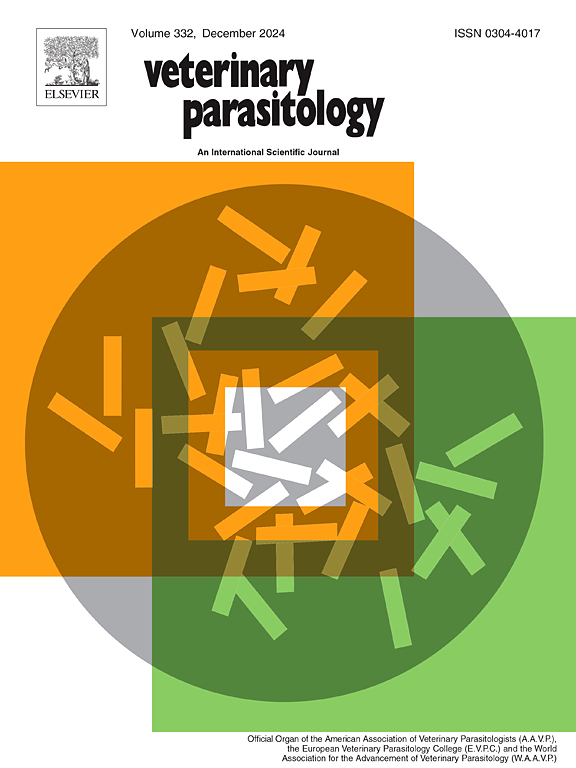Differential detection of ovine Theileria species using loop-mediated isothermal amplification combined with nanoparticle-based lateral flow biosensor
IF 2
2区 农林科学
Q2 PARASITOLOGY
引用次数: 0
Abstract
Ovine theileriosis is an important tick-borne protozoan disease. It has been reported that three Theileria species are responsible for ovine theileriosis in China, which are T. luwenshuni, T. uilenbergi, and T. ovis. Here, we established three detection techniques based on loop-mediated isothermal amplification (LAMP) and nanoparticle-based lateral flow biosensor (LFB) for the infection of the three Theileria species. Three LAMP primer sets were designed targeting the nucleotide sequences of the 28S rRNA gene of T. luwenshuni, T. uilenbergi, and T. ovis. We used LAMP coupled with real-time fluorescence detection to optimize the concentrations of dNTP Mix, MgSO4, and Bst 2.0 DNA polymerase, as well as the reaction temperature of the LAMP assay, and then combined LAMP with LFB (LAMP-LFB). The entire detection assay process, including genomic DNA extraction (40 min), LAMP reaction (40 min), and LFB readout (<5 min), can be completed within 85 min. The established assays can specifically detect species of T. luwenshuni, T. uilenbergi, and T. ovis infection without cross-reaction with other Theileria, Babesia, and Anaplasma species. The detection limits of the LAMP-LFB assays for T. luwenshuni, T. uilenbergi, and T. ovis plasmid templates were 2.72 × 102 copies/μL, 2.96 × 103 copies/μL, and 3.05 × 101 copies/μL, respectively. Finally, we compared the established LAMP-LFB assay with the traditional PCR assay. The results showed that the total coincidence rates were 96.67 % (T. luwenshuni), 96.67 % (T. uilenbergi), and 93.33 % (T. ovis), respectively. In general, we developed a rapid, simple, sensitive, and specific technique for differential detection of T. luwenshuni, T. uilenbergi, and T. ovis infection in small ruminants.
环介导等温扩增结合纳米颗粒横向流动生物传感器对绵羊希勒氏菌的鉴别检测
绵羊羊肠弧菌病是一种重要的蜱传原虫病。据报道,在中国有3种伊氏杆菌引起绵羊伊氏菌病,分别是鲁文顺氏T.、维伦堡氏T.和奥氏T.。在此,我们建立了基于环介导等温扩增(LAMP)和基于纳米颗粒的横向流动生物传感器(LFB)的三种检测技术来检测三种希氏菌的感染。设计了3套LAMP引物,分别针对鲁文顺氏弓形虫、乌伦伯格弓形虫和奥维斯弓形虫的28S rRNA基因核苷酸序列。我们利用LAMP结合实时荧光检测优化dNTP Mix、MgSO4和Bst 2.0 DNA聚合酶的浓度和LAMP实验的反应温度,然后将LAMP与LFB (LAMP-LFB)结合。整个检测分析过程,包括基因组DNA提取(40 min)、LAMP反应(40 min)和LFB读出(<5 min),可在85 min内完成。所建立的检测方法可特异性检测鲁文氏弓形虫、维伦堡氏弓形虫和卵巢弓形虫感染,与其他伊氏菌、巴贝斯虫和无形体菌无交叉反应。LAMP-LFB法对鲁文顺尼、乌伦伯格和紫霉质粒模板的检出限分别为2.72 × 102 copies/μL、2.96 × 103 copies/μL和3.05 × 101 copies/μL。最后,我们将建立的LAMP-LFB方法与传统的PCR方法进行了比较。结果表明,总符合率分别为96.67 %、96.67 %、93.33 %。总的来说,我们建立了一种快速、简单、灵敏、特异的小反刍动物鲁文舒尼、维伦伯格和卵巢t感染鉴别检测技术。
本文章由计算机程序翻译,如有差异,请以英文原文为准。
求助全文
约1分钟内获得全文
求助全文
来源期刊

Veterinary parasitology
农林科学-寄生虫学
CiteScore
5.30
自引率
7.70%
发文量
126
审稿时长
36 days
期刊介绍:
The journal Veterinary Parasitology has an open access mirror journal,Veterinary Parasitology: X, sharing the same aims and scope, editorial team, submission system and rigorous peer review.
This journal is concerned with those aspects of helminthology, protozoology and entomology which are of interest to animal health investigators, veterinary practitioners and others with a special interest in parasitology. Papers of the highest quality dealing with all aspects of disease prevention, pathology, treatment, epidemiology, and control of parasites in all domesticated animals, fall within the scope of the journal. Papers of geographically limited (local) interest which are not of interest to an international audience will not be accepted. Authors who submit papers based on local data will need to indicate why their paper is relevant to a broader readership.
Parasitological studies on laboratory animals fall within the scope of the journal only if they provide a reasonably close model of a disease of domestic animals. Additionally the journal will consider papers relating to wildlife species where they may act as disease reservoirs to domestic animals, or as a zoonotic reservoir. Case studies considered to be unique or of specific interest to the journal, will also be considered on occasions at the Editors'' discretion. Papers dealing exclusively with the taxonomy of parasites do not fall within the scope of the journal.
 求助内容:
求助内容: 应助结果提醒方式:
应助结果提醒方式:


